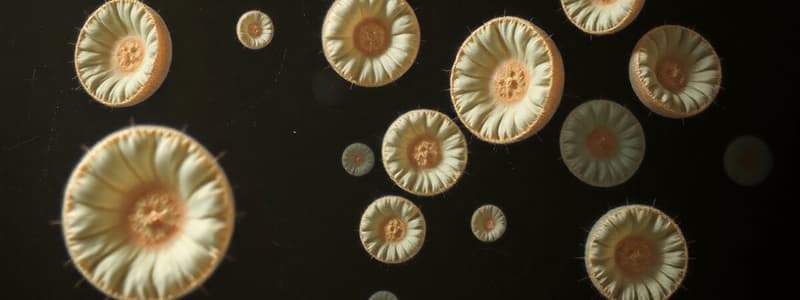Podcast
Questions and Answers
What is the primary function of basophils in the immune response?
What is the primary function of basophils in the immune response?
- To mediate allergic reactions and kill parasites (correct)
- To produce antibodies against antigens
- To transport oxygen in the bloodstream
- To directly attack infected cells
Which of the following accurately describes lymphocytes?
Which of the following accurately describes lymphocytes?
- They are the largest type of white blood cells.
- They are responsible for long-term immunity and include T and B lymphocytes. (correct)
- They can only survive a few days in the bloodstream.
- They possess significant phagocytic ability.
What is the main role of histamine secreted by basophils?
What is the main role of histamine secreted by basophils?
- To promote the destruction of parasites
- To attract other white blood cells by causing blood vessels to leak (correct)
- To inhibit the function of lymphocytes
- To kill cancerous cells
Where do all lymphocytes begin their development?
Where do all lymphocytes begin their development?
Which characteristic is unique to agranulocytes compared to other white blood cells?
Which characteristic is unique to agranulocytes compared to other white blood cells?
What is the primary role of neutrophils in the immune response?
What is the primary role of neutrophils in the immune response?
Which of the following statements about WBCs is correct?
Which of the following statements about WBCs is correct?
Which type of WBC is characterized by having few or no visible granules?
Which type of WBC is characterized by having few or no visible granules?
What is a notable characteristic of eosinophils?
What is a notable characteristic of eosinophils?
How are WBCs primarily categorized?
How are WBCs primarily categorized?
Flashcards are hidden until you start studying
Study Notes
White Blood Cells (WBCs)
- A microliter of blood contains between 5000 and 10000 WBCs
- WBCs are crucial for fighting infection.
- There are 5 types of WBCs
- All WBCs contain a nucleus, and other internal structures.
Granulocytes
- Contain obvious granules (when viewed under a microscope)
- There are 3 types of granulocytes:
Neutrophils
- Most abundant WBC
- Highly mobile, and can quickly move from blood vessels to tissue.
- Engulf and digest foreign materials.
- Dead neutrophils form the main component of pus
Eosinophils
- Found in large numbers in the respiratory and digestive tracts.
Basophils
- Involved in allergic reactions and killing parasites
- Have limited phagocytic ability.
- Secrete heparin (an anticoagulant) to prevent clotting and allow WBC entry.
- Secrete histamine, which causes blood vessels to leak and attract WBCs.
Agranulocytes
- Lack cytoplasmic granules.
- Include lymphocytes and monocytes.
Lymphocytes
- The second most numerous WBC
- Smallest of the WBCs
- Responsible for long-term immunity.
- Two types of T lymphocytes:
- T lymphocytes: directly attack infected or cancerous cells.
- B lymphocytes: produce antibodies against specific antigens.
- All lymphocytes start in the bone marrow, with some maturing there, and others migrating to the thymus to finish developing.
- After maturation, lymphocytes colonize the organs and tissues of the lymph system, like the spleen and lymph nodes.
- Continuously cycle between the bloodstream and lymph system.
- Can survive for weeks to decades.
Studying That Suits You
Use AI to generate personalized quizzes and flashcards to suit your learning preferences.



